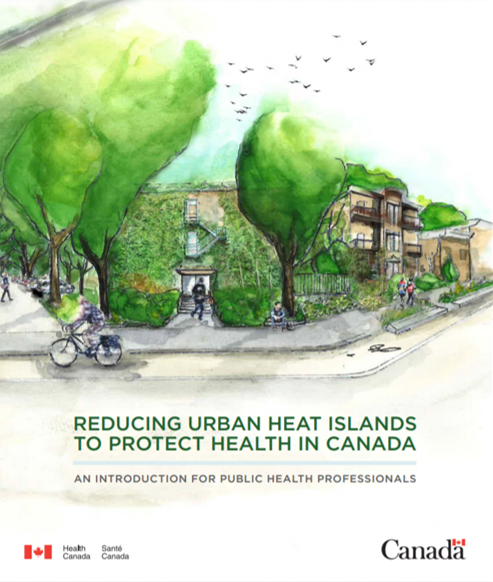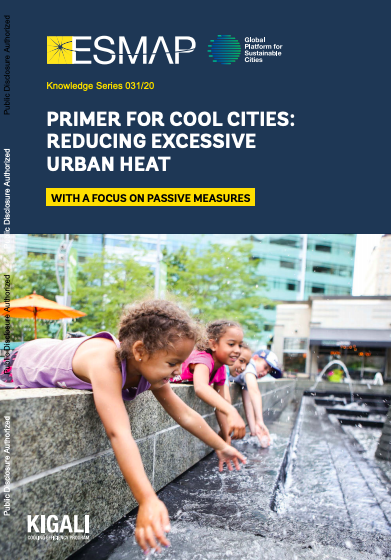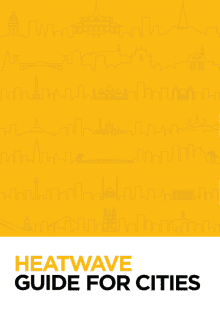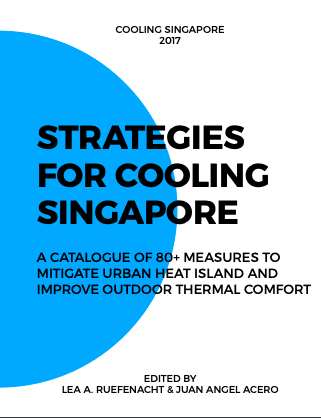Over half of the world population now lives in cities that are disproportionately heating due to climate change and urban heat island effects.
At the same time, cities represent innovative hubs that have the potential to catalyze new opportunities, such as good governance, protective social measures and urban design for cooling.
- Cities tend to be hotter than rural areas – this is known as the Urban Heat Island Effect.
- The impacts of urban heat islands are often worse in areas with high population density and low tree cover, resulting in large temperature variations between neighborhoods.
- Extreme heat interacts with and amplifies the effects other stressors such as air pollution and water scarcity.
- Heat exposure in cities is deadly. Long-term urban planning, civic engagement, and effective cross government emergency management can save lives and keep communities healthy.
Urban Heat Islands
Temperatures in cities tend to be hotter than the surrounding countryside due to the prevalence of surfaces that retain heat and release it slowly; this is called the Urban Heat Island Effect.
Cities consist of environments that are intensely modified by humans, which may also lead to hotspots within cities where the temperature is even higher. This is due to factors such as buildings that block wind, the use of dark-coloured paving or asphalt, waste heat generated by vehicles, air conditioners and industrial facilities, and a lack of vegetation to cool parts of a city. Source Heatwave Guide for Cities
In cities with wet climates, high humidity further amplifies urban heat conditions.
The effects of urban heat islands are often worse in the densest parts of the city with the fewest greenspaces. Identifying and visualizing differences in heat exposure and impacts across cities can raise awareness in high risk communities and help target policies and interventions that protect the most vulnerable.
Video
This WMO documentary case study offers insight into the impacts of heatwaves on the city of Athens and its residents. It underscores the effectiveness of combining early warning systems in the short term and nature-based solutions in the long term as crucial strategies for adapting to climate change.
Heat and Air Pollution
Extreme heat can interact with – and compound the effects of – air pollution. Heat and sunlight are two ingredients that can intensify ground-level pollution by mixing with nitrous oxide gases (from sources like car exhausts) to create ozone, a toxic pollutant. This is why hot days are often also hazy, which can be detrimental to health – particularly for those with lung conditions like asthma and cardiovascular disease. The combination of heat and air pollution leads to higher death rates than either factor working independently.
Although opening windows when the air temperature is cooler outside than inside is commonly advised to lower indoor temperatures, during periods of high air pollution levels this is not advised.
High temperatures and dry conditions also amplify wildfire risk. Increasingly extreme fires are being observed during hot summers in all world regions. Poor air quality due to wildfire smoke can cause shortness of breath, lung irritation, fatigue and eye irritation, and trigger asthma attacks and other health effects.
Management and Adaptation Solutions
Urban adaptation and extreme heat management is multi-faceted and calls upon action from a broad range of actors and authorities. Cities must plan for future heat conditions, while also building effective early warning systems, public preparedness, legislation, and health interventions that protect the most vulnerable populations.
Role of Municipal Governments and Systems
Cities have a unique potential to adapt to changing heat risks through effective risk management at multiple levels. All cities should assess heat risk and devise plans and partnerships for reducing and managing risks. Cities can effectively coordinate and incentivize multi-sectoral actors; and strengthen community engagement in policymaking.
During hot weather, the failure or limited access to critical utilities, such as power, water, and transport, can also make urban vulnerability worse. The loss of power during hot weather can leave people without cooling when needed most. In communities where access to water does not reach everyone, – such as those living in slums and informal settlements – people may not be able to stay sufficiently hydrated to reduce the effects of extreme heat. Cities can help plan and coordinate risk management policies and plans across civic utilities.
Cross-Departmental Collaboration
The mandate to reduce heat risks does not fit squarely within any traditional sector or government department. A variety of agencies have crucial roles to play in the overall effort to reduce heat risks. These include disaster/emergency management, health and social services, transport, power and water, city planning and meteorological services. A designated lead coordinating agency can help effective collaboration and planning. Source Heatwave Guide for Cities
Emergency Preparedness
Preparedness should happen long before an emergency. Actors and information should be coordinated before and during the heat season, complemented by early warning – early action systems during a heat emergency. Strong multi-agency preparedness calls for effective communication between stakeholders, including national and local governments, universities, media, healthcare and social protection systems, NGOs and humanitarian actors, as well as affected populations.
Location and Context Specific Risk Management
Different communities are affected very differently by heat. Cities are mosaics of linguistic, cultural, and socio-economic diversity, and characterized by microclimates and diverse living conditions. Localized understanding of heat risks, risk perceptions, and available cooling options are critical to effective intervention design. Epidemiological studies, social science, risk assessment and urban heat mapping can provide insights that address the differentiated needs of vulnerable groups into risk planning and effective responses.
Built Environment
Strategic and environmentally sustainable urban development must consider future climate impacts and projected temperature exposures in coming decades. Technical and biophysical materials and design in housing, roads, greenspace can help manage and reduce long-term urban heat burdens.
Key Resources
Guidance
Report
Toolkit
Publication
Research
Presentation
Learn more
For information on personal cooling and heat illness detection and management, please see our section on managing and adapting to heat in the body.





